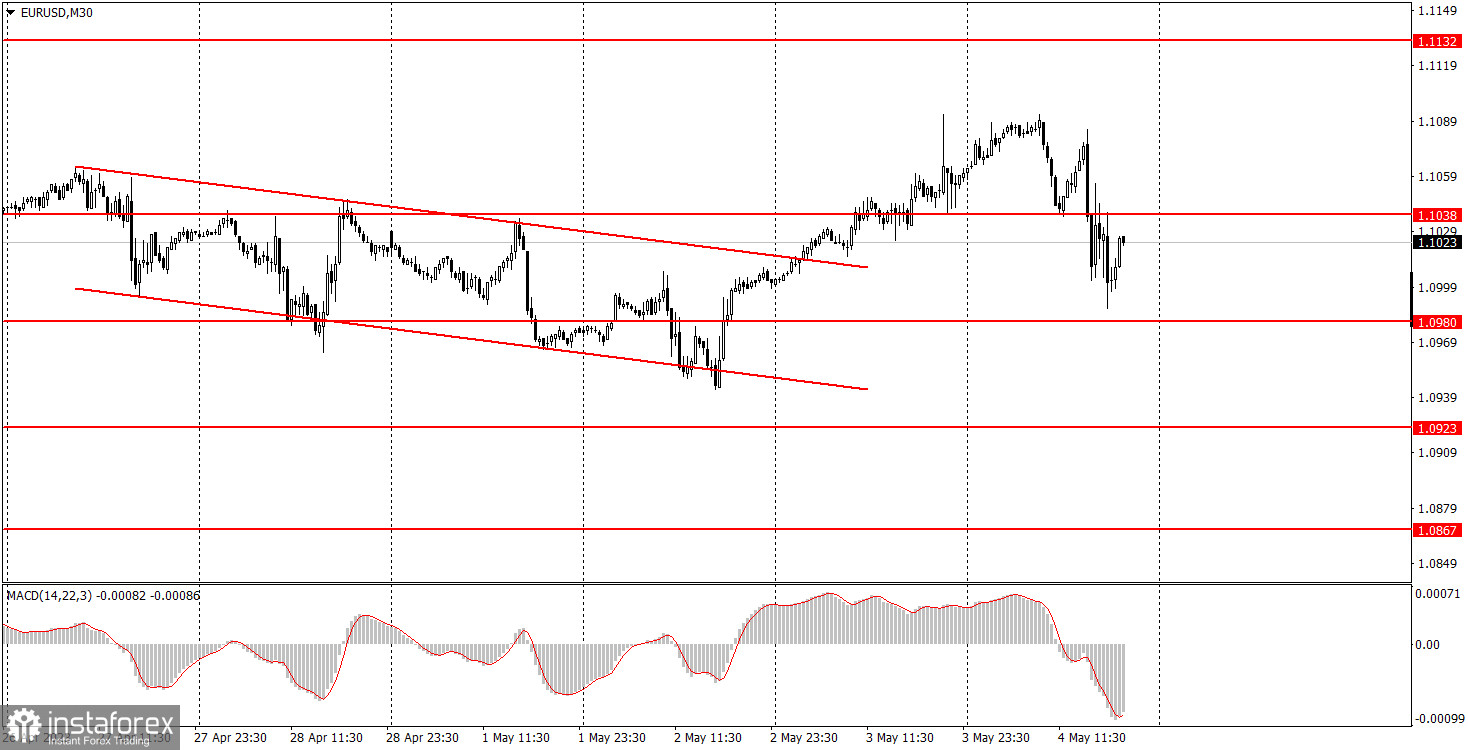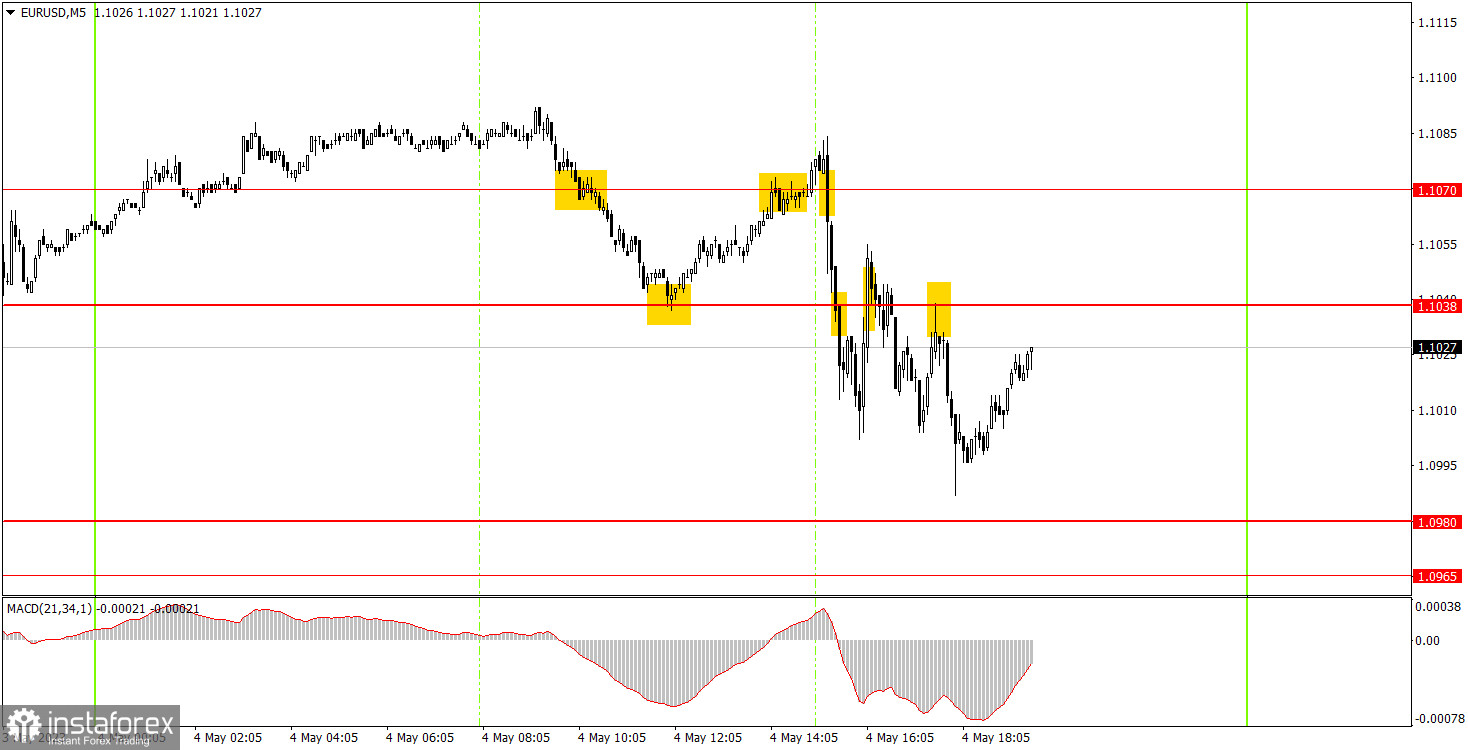Analyzing Thursday's trades:
EUR/USD on 30M chart

The EUR/USD pair collapsed on Thursday, but not too much. The new uptrend is still applied. Undoubtedly, the euro fell due to the results of the European Central Bank meeting. Moreover, the key rate was raised again, this time only by 0.25%, and not by 0.5%, as in the last meetings. Market participants were disappointed with this particular decision, some of whom expected an aggressive tightening of monetary policy by 0.5%. However, the ECB, as we assumed, decided to slow down the rate hike. Now this means that the tightening cycle is coming to an end, and we should expect one or two more hikes at the upcoming meetings, after which the rate will stop rising. In my opinion, this is a good enough reason for the euro to stop appreciating. We once again expect a sharp decline in the EUR/USD pair. The EU Services PMI turned out to be slightly better than forecasts, but this report had no significance on Thursday against the backdrop of two central bank meetings.
EUR/USD on 5M chart

On the 5-minute chart, the pair moved in a chaotic manner, especially in the second half of the day. Sharp movements and frequent reversals began at the start of the European trading session as the market began to get nervous. Therefore, you shouldn't have opened any positions during the US trading session. In the first half of the day, the pair initially formed a sell signal by overcoming the 1.1070 level and subsequently dropped to the 1.1038 level and rebounded from it. Beginners could have earned about 10 points of profit on the short position. The bounce from the 1.1038 level could also have been worked out, and the price subsequently rose back to 1.1070, yielding another 10 points of profit. Overall, volatility was low.
Trading tips on Friday:
On the 30-minute chart, the pair collapsed on Thursday but did not show strong downward movement. The movement was impulsive, and it could end on Friday, with the pair resuming growth. Take note that this is not a "technical" beginning of the decline, it is just a market reaction to the ECB meeting. On the 5-minute chart, consider levels 1.0792, 1.0857-1.0867, 1.0920-1.0933, 1.0965-1.0980, 1.1038, 1.1070, 1.1132, 1.1184, 1.1228. As soon as the price passes 15 pips in the right direction, you should set a Stop Loss to breakeven. On Friday, the European Union will release a retail sales report, but it is not the most important report of the day. The United States will release much more important reports like the NonFarm Payrolls and the unemployment rate. The market will focus on these reports.
Basic rules of the trading system:
1) The strength of the signal is determined by the time it took the signal to form (a rebound or a breakout of the level). The quicker it is formed, the stronger the signal is.
2) If two or more positions were opened near a certain level based on a false signal (which did not trigger a Take Profit or test the nearest target level), then all subsequent signals at this level should be ignored.
3) When trading flat, a pair can form multiple false signals or not form them at all. In any case, it is better to stop trading at the first sign of a flat movement.
4) Trades should be opened in the period between the start of the European session and the middle of the US trading hours when all positions must be closed manually.
5) You can trade using signals from the MACD indicator on the 30-minute time frame only amid strong volatility and a clear trend that should be confirmed by a trendline or a trend channel.
6) If two levels are located too close to each other (from 5 to 15 pips), they should be considered support and resistance levels.
On the chart:
Support and Resistance levels are the levels that serve as targets when buying or selling the pair. You can place Take Profit near these levels.
Red lines are channels or trend lines that display the current trend and show in which direction it is better to trade now.
The MACD indicator (14, 22, and 3) consists of a histogram and a signal line. When they cross, this is a signal to enter the market. It is recommended to use this indicator in combination with trend patterns (channels and trendlines).
Important announcements and economic reports that can be found on the economic calendar can seriously influence the trajectory of a currency pair. Therefore, at the time of their release, we recommend trading as carefully as possible or exiting the market in order to avoid sharp price fluctuations.
Beginners on Forex should remember that not every single trade has to be profitable. The development of a clear strategy and money management is the key to success in trading over a long period of time.
 English
English 
 Русский
Русский Bahasa Indonesia
Bahasa Indonesia Bahasa Malay
Bahasa Malay ไทย
ไทย Español
Español Deutsch
Deutsch Български
Български Français
Français Tiếng Việt
Tiếng Việt 中文
中文 বাংলা
বাংলা हिन्दी
हिन्दी Čeština
Čeština Українська
Українська Română
Română

